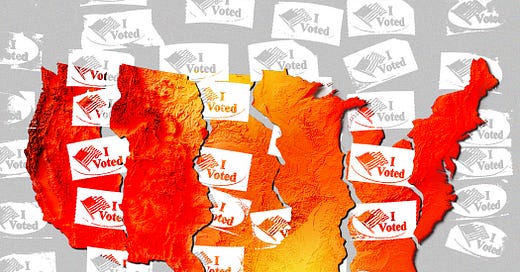Are We Headed for Two Demagogic Parties?
Political “dealignment,” the Seventh Party System, and lessons for the left from recent history of the right.
AMERICAN POLITICS HAS ALMOST ALWAYS been a two-party system, although the parties in that system—their names, platforms, and voting coalitions—have shifted many times. Since the latter half of the twentieth century, the country has been in what political scientists call the Sixth Party System—which is to say, the sixth period of relatively stable coalitions.
Scholars don’t agree if this equilibrium still holds or if it’s in the process of fracturing and reassembling into a Seventh Party System.
What we do know is that before the Sixth Party System came about, there was a period of what some scholars call “dealignment,” meaning: When Republicans and Democrats abandoned their parties in the 1960s, they didn’t just immediately re-sort—they took some time to bring about the realignment. Dealignment was the bridge era in which liberal/Northern Republicans and conservative/Southern Democrats—and other relevant partisan subgroups—traveled to their new homes.
It certainly appears as though the country is undergoing a period of dealignment right now. Regardless of the inside-baseball observation that most independent voters still behave like partisans, “independent” has been the most popular response to Gallup’s party affiliation survey since November 2012, and by a lot in most months. What is less clear is where this bridge era will lead. Based on the modern realities of politics—intense negative polarization, structural incentives, uncertainty and apathy in the great “middle” of America, other factors we don’t yet know or appreciate—one possible outcome is cause for concern: that the American left will imitate the recent trajectory of the right.
LET’S STIPULATE all the big-picture things we know about today’s Republican party:
Donald Trump is its leader, indefinitely.
It’s impossible to cross him and keep one’s job as a formal party member if that job is based in Washington; and it takes special circumstances to achieve it at the state level.
Trump himself will not last forever, and there will be a Death of Stalin period.
Regardless—Trumpism will outlast Trump. His lifestyle brand of politics won’t disappear automatically when he does.
Now let’s stipulate some things we know about the Democratic party:
Joe Biden himself is a normal president and he’s leading his party through a period of relative normalcy—by which is meant stable and within the historical norms of American governance, despite his administration’s occasional testing of those norms (e.g., student loan forgiveness) and abnormal ideas that live on the ideological fringes but have no prospects for coming about (e.g., court packing).
Democratic congressional leadership and leadership at the state level—Josh Shapiro, Gretchen Whitmer, et al.—are normal.
Even the baton handoff from the era of Nancy Pelosi/Steny Hoyer/James Clyburn to Hakeem Jeffries and his team was normal.
But that’s about the here and now. Democrats should be asking themselves a question in 2023 that Republicans should’ve asked themselves around 2008—because remember that George W. Bush was a normal (if flawed) president, too; and so were Republicans’ congressional and state leadership; and so too was the baton handoff to the era of Eric Cantor/Kevin McCarthy/Paul Ryan.
And that question is: “Do we represent where the party is headed?”
Because here it seems plausible that the answer for Democrats is “no.”
JAMELLE BOUIE RECENTLY wrote that, “Democrats are in comparatively better shape [than Republicans], but that’s not the same as good shape. There is a real disconnect between many younger Americans and the Democratic Party, on issues you might expect, like student loan debt, and issues you might not, like U.S. support for the Israeli government.”
It’s unclear if today’s young progressive activists will age into sober moderation or conservatism. After all, they have access to and facility with the same tools someone such as Matt Gaetz does: social media, alternative programming, and small-dollar donor engagement, to name one unholy trinity of twenty-first-century politics. Plus the young left has the academy, and all that entails: an institutional foundation essential to political upheaval.
Overhanging all this are three key observations:
Government policy is not the animating force of the GOP, and the purpose it serves among the party base is primarily to define Republicans in opposition to Democrats.
The Democratic party’s policy agenda—as pursued by its elected leaders in Washington—is cautious, closer to the median voter than the median progressive activist, and does not resonate much with the party’s base, either.
The incentive structure of our politics values the average primary voter much more than the average general-election voter.
Add that up, and it seems there’s a realistic chance we could wind up in a two-party system in which one party represents rightwing demagoguery and the other party succumbs to leftwing demagoguery.
The hope is that if this comes to pass, adults in the Democratic party, having seen what happened to Republicans, close ranks quickly and strongly enough that the fringe doesn’t take over the institution. Kind of how a significant mass of Democrats has institutionally held firm on Israel against recent antisemitism in the streets and on campus.
But how long can that hold if it’s not what the base wants to hear?
A FEW YEARS AGO, the group More in Common released a report called Hidden Tribes that created a taxonomy of American voters. The result is a map of Americans’ political attitudes that is more descriptive than voters are used to seeing.
There are seven categories, split into two primary subgroups: the vast “exhausted majority,” which represents two-thirds of the country, and the “wings” on the left and right, representing just a third.
Yet it’s the third that controls politics for the whole.
Hidden Tribes posits that liberals comprise three groups, with the following characteristics:
Progressive Activists: younger, highly engaged, secular, cosmopolitan, angry.
Traditional Liberals: older, retired, open to compromise, rational, cautious.
Passive Liberals: unhappy, insecure, distrustful, disillusioned.
Where are the passive liberals more likely to migrate? Who will speak to their unhappiness and disillusionment more—the rational compromisers or highly engaged angry people?
Joe Biden’s Democratic party is obviously “traditionally liberal.” But the energy of the Democratic base—and the numbers—are obviously with passive liberals and progressive activists.
If there were certainty that the Democratic party could be a strong institution and hold off its leftist flank, then there’d be no need to worry over forecasts of its future. Because there are always baroque and zany ideas and political efforts that create societal problems instead of solving them. But given what is known about the incentive structure of American politics and the struggles with mass democracy around the world more generally, how could there not be concern?
Notwithstanding the complexity of political trends, the dissatisfaction and frustration of partisans and ideologues has fueled dealignment on the right. There is no law of politics that says it can’t happen on the left. Its broad range of reactions to Israel in the last month, President Biden’s sagging poll numbers, and the three-guys-walk-into-a-bar version of presidential challengers—a moderate Democrat (Dean Phillips), a socialist (Cornel West), and an anti-vaxxer (RFK Jr.)—put the possibility into relief.






